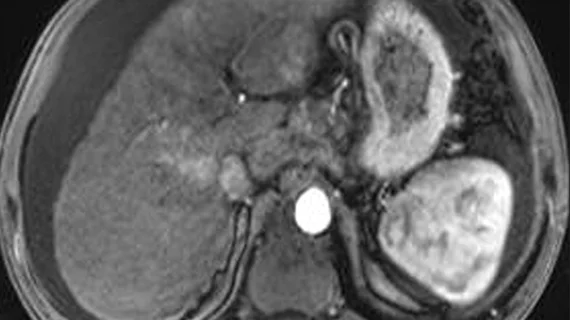Abbreviated MRI protocols present suitable alternatives for liver cancer screening
Abbreviated MRI protocols could pose as a sufficient, potentially higher quality alternative to ultrasound when screening patients for hepatocellular carcinoma (HCC).
Ultrasound is the routine method for seeking HCC, but its utility is limited by numerous factors, including patient body habitus, operator experience and certain liver conditions, like cirrhosis, all of which contribute to decreases in sensitivity. Previous studies have indicated that hepatobiliary-specific contrast MRI can improve the diagnostic accuracy of diagnosing HCC, but this also comes with caveats, like accessibility and concerns about cost-effectiveness.
There has been interest in abbreviated noncontrast MRI protocols for HCC screening, though the method has not yet become routine. This could be due to study results that have varied in both their methodology and reliability. To clarify the diagnostic utility of abbreviated MRI (AMRI) protocols, a team of experts recently conducted a systemic review of the literature on the topic, collecting and comparing all prior quality data available. They published their review in Academic Radiology.
"Despite the increasing interest in AMRI for HCC screening, there exist differences and inconsistencies in the reported results within the previous literature, which might influence clinical decision-making and selection,” Cong Wang, from the Department of Medical Imaging at Henan Provincial People’s Hospital, and colleagues explained. “Moreover, the sample size of these published studies is relatively small, and the statistical methods of some studies lack relative scientific reliability, which makes the results lack robustness in clinical application.”
The team narrowed their analysis down to 19 out of 769 papers. Combined, they calculated the pooled sensitivity and specificity of AMRI for HCC to be 0.85 and 0.93, respectively. A subgroup analysis of different abbreviated protocols further evaluated the method’s utility; the pooled sensitivity and specificity of noncontrast AMRI and hepatobiliary phase images (HBP) were 0.84 and 0.92, while T2 and diffusion weighted images in the HBP protocol had the highest diagnostic efficacy.
These protocols are accompanied by multiple benefits and could be utilized in situations when ultrasound imaging is insufficient, the group suggested.
“Based on previous studies and the results of our meta-analysis, AMRI offers fewer scan sequences, lower time and economic costs, and higher diagnostic efficacy, suggesting that AMRI might be used as an alternative tool to ultrasound for HCC surveillance in clinical screening,” the team concluded.
The study abstract is available here.

